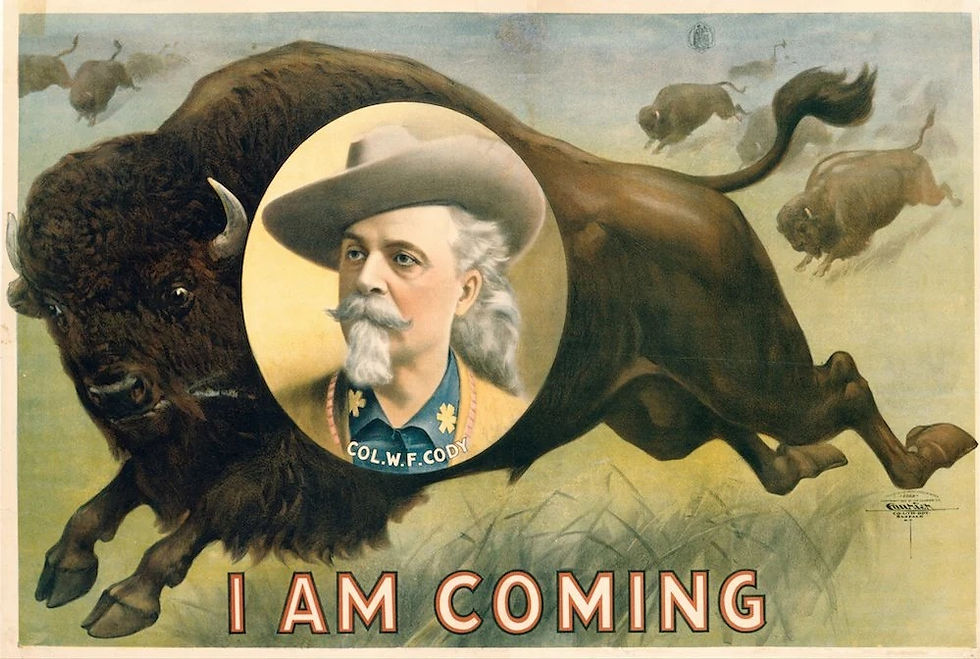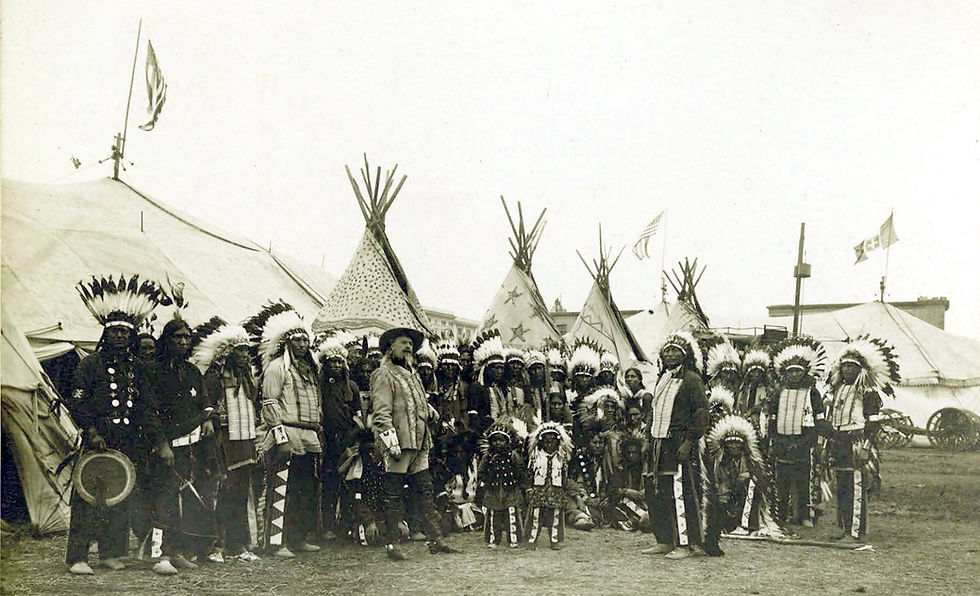Buffalo Bill & The Indians
- Matthew Kerns

- May 9, 2023
- 5 min read
When people think of Buffalo Bill Cody, they often get caught up on two historical fallacies. The first is that Bill Cody was a horrific slaughterer of the American bison, otherwise known as the buffalo. The second is that his participation in the near-extermination event of the buffalo was driven by genocidal urges and federal dollars to deny Native American tribes their primary food source in hopes of eliminating them entirely.

I see this interpretation of Cody's buffalo hunting days a lot, but I don't believe it is entirely accurate. William F. Cody hunted bison to feed the westward expansion of the railroad, but only for about 18 months. By the end of 1869, he worked full-time as a scout for the Army at Fort McPherson. During those 18 months, he earned a reputation as a great buffalo hunter, but he didn’t stand on a distant hill with a high-powered rifle and a looking glass, picking off docile creatures with no danger to himself. Bill Cody hunted the same way the Sioux, Cheyenne, and Pawnee did. He rode his horse towards a herd, separated the animal he would harvest, and ran alongside it until he could get the best shot possible. Cody killed a few animals at a time and brought them back to be used to feed the men working on expanding the railroad west. Despite what many think, he was never a hide hunter and never slaughtered buffalo indiscriminately for either the choice cuts (tongue and loin) or their hides.

By 1873, when desperate economic times made hide hunting more attractive, Buffalo Bill and Texas Jack had left the prairies of Nebraska and the herds of buffalo that roamed it behind to become successful (and quite wealthy) actors. They would occasionally return west to hunt but were never again a significant factor in the decline of the bison.
As part of his job as a scout, Buffalo Bill was involved with several altercations with Miniconjou, Lakota, Brule, Cheyenne, etc. Still, he never set out to murder Native Americans or to eliminate the bison, the staple of their diet, directly.
That said, Bill Cody did kill multiple Native American men in conflict, and those incidents, especially his combat with and killing of Yellow Hair, were inflated and magnified in dime novels and on stage. He became a legendary "Indian fighter" more because of the legend than the reality. Cody, like the Native people he fought against, knew that when they went to war someone was going to kill and someone was going to be killed. Each man fought desperately to ensure that he was the former, and though they were enemies, each man held a measure of respect for his adversary.

Likewise, Texas Jack was involved in conflicts with Sioux, Cheyenne, and Comanche warriors and developed a reputation as an "Indian fighter" despite having warm relations with the Pawnee tribe, joining them on their summer buffalo hunt in 1872, writing warmly about them in national publications, and being requested personally to join them by Pawnee head chief Pitaresaru (Chief of Men). Texas Jack also involved Cayuse native Donald McKay and his wife and daughter in his show well before Buffalo Bill ever brought Sioux into his Wild West shows.
Whatever failing Cody exhibited in his younger life in regard to Native Americans must be contrasted with his later life. His inclusion of Lakota in his Wild West show, including Sitting Bull himself, allowed them to travel, but more importantly to maintain and display their ceremonial dances and customs at a time when they were prevented by the United States government and Army from holding their religious ceremonies on the reservations. Cody paid the Native men and women in his show the same as he did the white cowboys, treated them fairly, kept families together, and was regarded as a warm friend by a great many of the Lakota that traveled with him.

Over time, Buffalo Bill Cody became a stalwart advocate for Native peoples and their rights. In the same way, Cody’s inclusion of the bison in his Wild West shows made sure that spectators at the shows were endeared to the animals. Over time, they became a symbol of not just the Wild West, but of America writ large. Because the hundreds of thousands of people who saw the bison in Buffalo Bill’s Wild West now cared about the animals, they supported conservation movements that brought them back from the brink of extinction. The man who earned his name as a buffalo hunter became one of the primary forces in their survival.

Cody publicly blamed most of the trouble between white men and Native tribes on the white men. He said that:
"In nine cases out of ten where there is trouble between white men and Indians, it will be found that the white man is responsible Indians expect a man to keep his word. They can't understand how a man can lie."
Dr. George Kingsley, who hunted with Cody and Omohundro, wrote that “[Buffalo Bill and Texas Jack] have a sympathy and a tenderness toward the Indians infinitely greater than you will find among the greedy, pushing settlers, who regard them as mere vermin who must be destroyed for the sake of the ground on which depends their very existence. But these men know the Indian and his almost incredible wrongs, and the causes which have turned him into the ruthless savage that he is, and often have I heard men of their class say that, before God, the Indian was in the right, and was only doing what any American citizen would do in his place.”

I'm not saying Buffalo Bill Cody and Texas Jack Omohundro were saints, just that they were complex people, both a product of their times and the prevailing attitudes of it, but capable of rising to the challenge of treating people humanely in the face of those attitudes.
I'll leave the last words to those native men who knew Buffalo Bill and called him "Pahaska," or "long hair," and considered him a friend. Black Elk (Heȟáka Sápa) spoke of Cody's "strong heart," and reportedly was touched by his spirit of generosity. Sitting Bull (Tȟatȟáŋka Íyotake) treasured a hat that Cody had given him, and reportedly grew quite angry when a relative once wore it. "My friend Long Hair gave me this hat," the great Hunkpapa chief boasted," I value it highly, for the hand that placed it upon my head had a friendly feeling for me." And Chief Red Fox (Tokála Luta) offered this great praise to his friend after his death: "In my imagination, I can see his noble spirit winging over the lofty peak, and I bow my head in memory of one who always impressed me with kindness and compassion, and enriched me with the deeply entrenched integrity of his character."



Sugarcoated story. Buffalo Bill killed thousands of bison by himself and he also brought many people from the eastern United States and Europe out to the plains to slaughter bison. He played a very large part in destroying life for Native Americans. He was also a scout for the US Army and fought in many battles against Native Americans. Someone that actually cares about the Native Americans does not go around bragging about how he scalped one of them.
The only reason that he treated the Native Americans in his Wild West shows well is because he was making a fortune off of them, so he had to pay them enough to make sure they hung around.
This was a very good read, I learned some interesting facts about Buffalo Bill and Texas Jack, and more love it